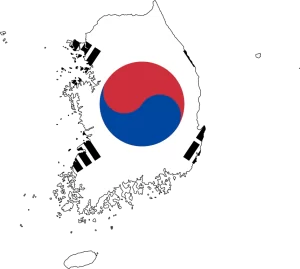Geographical position and Climate of South Korea
South Korea is located in East Asia, on the southern half of the Korean Peninsula, which juts out from the Asian mainland. The country is bordered by North Korea to the north, the Yellow Sea to the west, the Korea Strait and Japan to the southeast, and the East Sea (Sea of Japan) to the east.
South Korea has a temperate climate with four distinct seasons:
- Spring (March to May)
- Characterized by mild temperatures and a profusion of cherry blossoms across the country.
- Summer (June to August)
- Hot and humid with monsoon rains typically starting in late June and lasting until July or August.
- Autumn (September to November)
- Generally sunny and cool, considered one of the best times to visit due to the pleasant weather and colorful fall foliage.
- Winter (December to February)
- Cold and dry with snowfall, especially in the mountainous regions. The temperatures can drop significantly below freezing.
Brief History of South Korea
The history of South Korea, officially known as the Republic of Korea, begins with its establishment in 1948 following the end of World War II. After centuries as a unified kingdom under various dynasties, Korea was annexed by Japan in 1910. Post-World War II, the Korean Peninsula was divided along the 38th parallel, with the Soviet Union occupying the north and the United States occupying the south.
In 1950, the Korean War broke out when North Korean forces invaded South Korea. The conflict lasted until 1953 and ended with an armistice agreement, but no formal peace treaty was signed, leaving the two Koreas technically still at war.
Post-war, South Korea experienced political turmoil while rapidly developing its economy during the latter half of the 20th century. The country transitioned from a military dictatorship to a democratic government in the late 1980s.
South Korea’s “Miracle on the Han River” refers to its transformation from the ruins of the Korean War to becoming one of the world’s leading economies. Today, it is known for its advanced technology, automotive, and entertainment industries, as well as its vibrant culture and democratic society.
Religion
Religion in South Korea is diverse and includes a variety of beliefs and practices. The main religions are: Buddhism, Protestantism, Catholicism, Confucianism, Shamanism, Cheondoism and Won Buddhism. In addition to these, there are also small populations of Hindus, Muslims, and Sikhs. Many South Koreans also identify as non-religious or atheist, reflecting a trend towards secularism in contemporary society.
Language
The official language of South Korea is Korean. It is a language isolate, meaning it does not have any direct linguistic relatives, although there are some theories that suggest historical links to the Altaic languages. South Koreans also commonly study English as a second language, and it is widely taught in schools as part of the curriculum.

